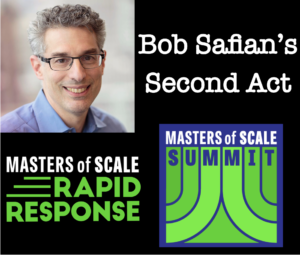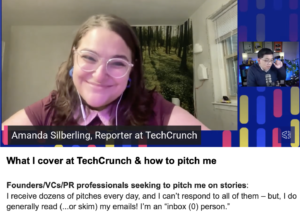
Q&A: Bob Safian, Masters of Scale
You may know Bob Safian as the former editor of Fast Company. As good a job as that was, Bob may be on to something even bigger and better…

You may know Bob Safian as the former editor of Fast Company. As good a job as that was, Bob may be on to something even bigger and better…

If you’re younger than 43 years old, Steve Lohr was reporting for the New York Times before you were born. Imagine all the stories he has written… the interviews he has conducted… and all the pitches he has seen.

Unlike most reporters you’ll meet, TechCrunch freelancer Amanda Silberling is no introvert. She truly wants you to understand what she does and why.
 Cade Metz is consistent. We interviewed him in 2008, 2012 and 2015. Each time he has carried the same message: though he reports on tech, it’s always about the people. This week we checked in with Cade to discuss Genius Makers, his new book about “the mavericks who brought AI to Google, Facebook and the world.” Again with the people!
Cade Metz is consistent. We interviewed him in 2008, 2012 and 2015. Each time he has carried the same message: though he reports on tech, it’s always about the people. This week we checked in with Cade to discuss Genius Makers, his new book about “the mavericks who brought AI to Google, Facebook and the world.” Again with the people!
 Forbes senior editor Alex Konrad gave us a metric ton of insight this month — one article just wasn’t enough. So this week we plumb the notebook of SWMS contributor Rhiannon Pacheco, who interviewed Alex earlier this month, and present the rest of Alex’s thoughtful and heartfelt advice for PR pros looking to win his attention.
Forbes senior editor Alex Konrad gave us a metric ton of insight this month — one article just wasn’t enough. So this week we plumb the notebook of SWMS contributor Rhiannon Pacheco, who interviewed Alex earlier this month, and present the rest of Alex’s thoughtful and heartfelt advice for PR pros looking to win his attention.
 Veteran IT freelancer Mike Vizard discusses his views of virtual events, whether he covers enterprise startups, and shares how he thinks of “news” these days. Interview was conducted July 2020.
Veteran IT freelancer Mike Vizard discusses his views of virtual events, whether he covers enterprise startups, and shares how he thinks of “news” these days. Interview was conducted July 2020.
 Sean Michael Kerner is a B2B tech reporter, and according to his LinkedIn profile, is an “Internet consultant, a strategy and developer/writer and sometimes entrepreneur.” While Sean no longer writes for eWeek, he recently picked up freelance work at Business Insider and still writes for Enterprise Networking Planet, eSecurity Planet, ServerWatch and ITPro Today.
Sean Michael Kerner is a B2B tech reporter, and according to his LinkedIn profile, is an “Internet consultant, a strategy and developer/writer and sometimes entrepreneur.” While Sean no longer writes for eWeek, he recently picked up freelance work at Business Insider and still writes for Enterprise Networking Planet, eSecurity Planet, ServerWatch and ITPro Today.
 How do you land coverage in WSJ Journal Reports? Pitch the beat reporters. “It’s hard to target these reports,” says senior editor Larry Rout. He explains that the best stories come from those with the domain expertise, be it in healthcare, energy or wealth management.
How do you land coverage in WSJ Journal Reports? Pitch the beat reporters. “It’s hard to target these reports,” says senior editor Larry Rout. He explains that the best stories come from those with the domain expertise, be it in healthcare, energy or wealth management.
 The New York Times has been around since 1851. According to SimilarWeb, the NYT gets 400 million unique visits each month from more than 250 countries. Naturally, PR pros want to plug into this prestige and power — which is why many NYT editors often suspect your motives when you approach them.
The New York Times has been around since 1851. According to SimilarWeb, the NYT gets 400 million unique visits each month from more than 250 countries. Naturally, PR pros want to plug into this prestige and power — which is why many NYT editors often suspect your motives when you approach them.
YOUR ACCOUNT
FRIDGE NOTES
When Axios prompted ChatGPT for basic background research on Wealthfront’s confidential IPO filing last week, the bot confidently detailed a Wealthfront investor deck. The problem? It appears to be entirely made up.
Indy media business experts Brian Morrissey and Jacob Cohen Donnelly have built two very successful businesses with both newsletters and face-to-face events. Axios has noticed this and has decided to get into the event space focusing on the economics of publishing, which of course is a topic close to home. Announced this week: an Axios event coming up in September. Hosts: Sara Fischer and Kerry Flynn.
ServiceNow has launched a special report on Fortune to jumpstart strategic spending on AI, illustrating workarounds for implementation problems, and otherwise illuminating the path to integrating AI into software operations. This is a branding exercise, of course, and perhaps is a sign that earned media is just not going get a strategic job done.
AIQ shows a big idea and how to leverage the prestige of Fortune without having to pitch stories to accomplish that same objective: you can just buy shelf space. In the case of AIQ, Fortune hired freelancer Sage Lazzaro — who used to work on staff there to create high-level content. So let’s keep an eye on this project, monitoring how well-respected it is… and whether its content gets surfaced in search engines.
Here are the details — Choose from 5 categories and 30+ subcategories. The awards are being promoted by Bhava Communications, an SWMS subscriber.
The guy also is the full-time “chairman” of Bally and Sassoon. On top of that, he’s also chairman of Foundry and 13 other companies. Well, 14, if you count his own private equity firm. How much time will he put into TC, understanding the subtleties of tech edit?